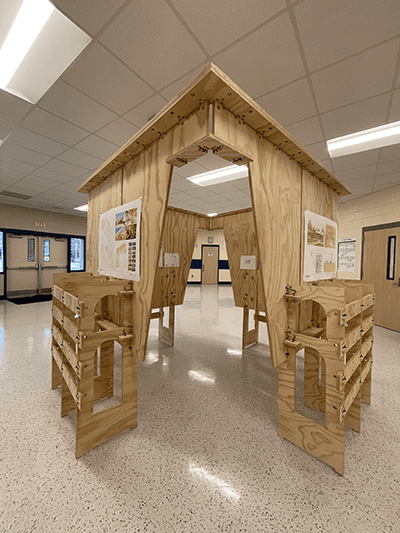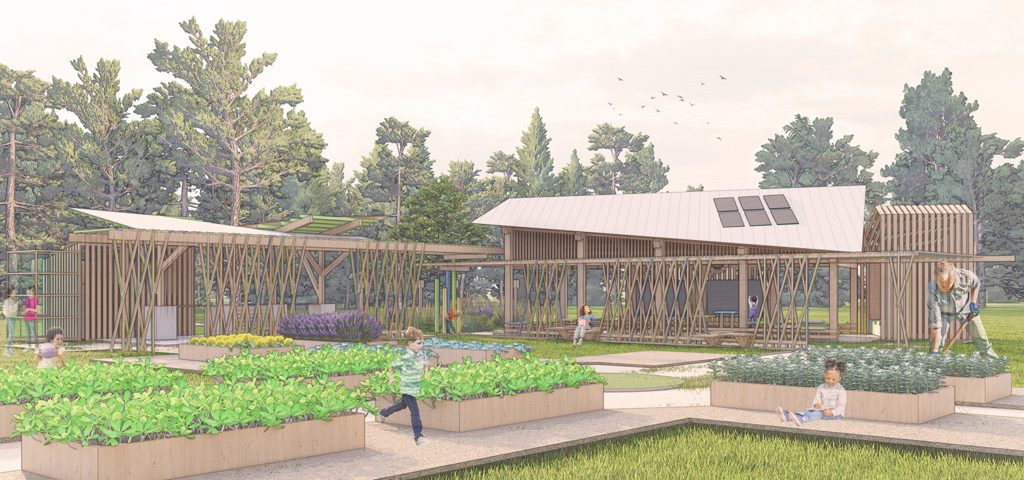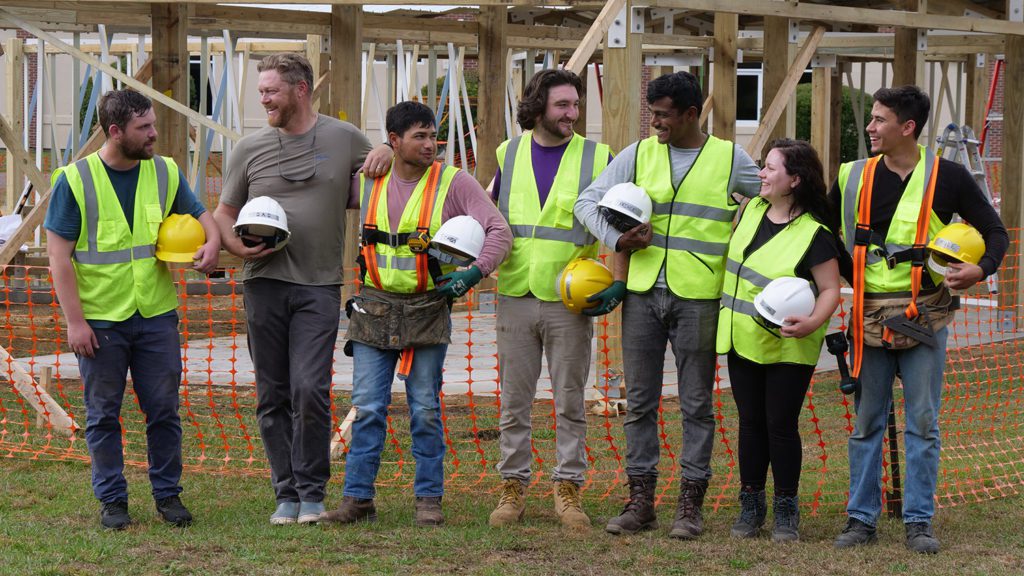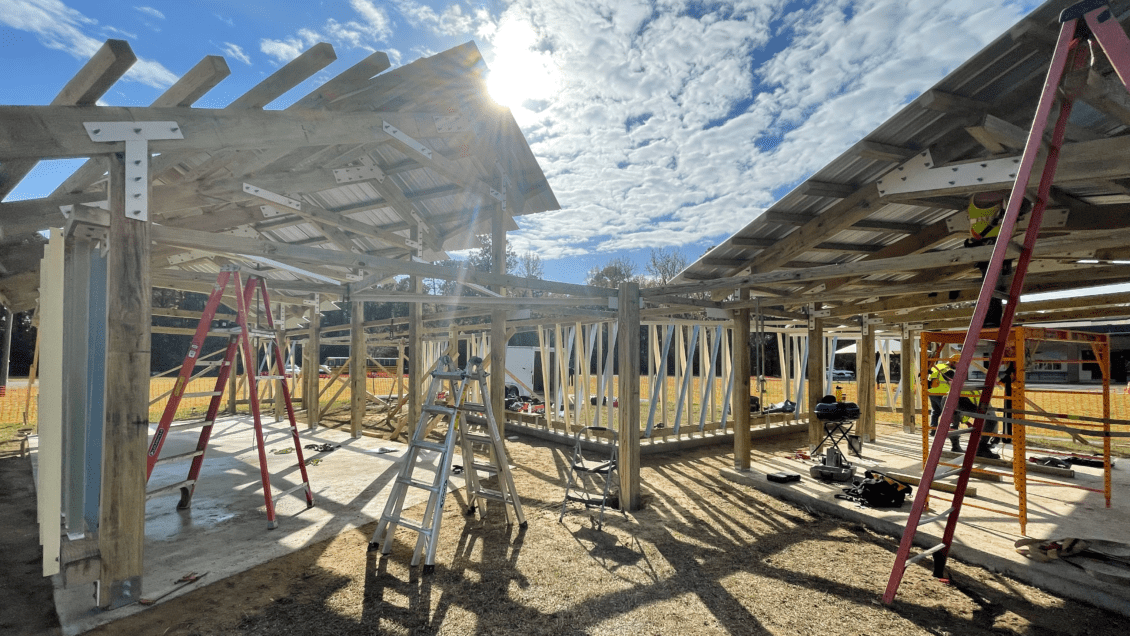Behind Edith L. Frierson Elementary School on Wadmalaw Island, Clemson University architecture students are building a structure that reimagines what a classroom can be. Their work is an extension of a transformation that principal Deborah Davis-Cummings began seven years ago.
“We knew that the school was at risk of being closed, and we tried to determine what would be the best type of program for our school, and we decided on Montessori,” Davis-Cummings recalled.
Since that turning point, the school’s population has grown from 64 to 157 students. While the school remains small, it is “land-rich,” boasting a 14-acre campus. Last year, Davis-Cummings met with her School Improvement Council to find ways to capitalize on their strengths.
“My vision for this campus, because it is such a beautiful space, is that not only will children be able to learn and grow, but that community members can come and be a part of this work as well,” she said.
The result, now nearing completion, will be the largest project ever completed by the Architecture+CommunityBUILD certificate program at the Clemson Design Center, Charleston (CDC.C), led by director David Pastre.
Learning together







Part outdoor classroom and part gardening center, the project combines two covered pavilion areas that join at the corners. The covered pavilions are arranged to be able to accommodate separate activities, but they are also arranged toward a shared focal point, giving the space versatility for multiple uses.
The design of the two spaces coming together mirrors the way both groups of students bonded.

“We did an activity with the elementary students that was really exciting because we got to hear what they wanted to see from the design,” said Amanda Wood, a Master of Architecture student at Clemson who worked on the build. “It was fun to interact them and make them part of the process.”
For both the Clemson students and Frierson students, the build process was a true learning experience. Second-year Master of Architecture student Kyle Kane expressed why the CommunityBUILD program—which has completed more than 20 projects for South Carolina communities—continues to attract students like him.
“I think that every architect should be in this process because it’s so valuable for our education to know how what we’re drawing actually stands up,” Kane said. “In the field, there’s a huge discrepancy between the builders and the architects.”
While the Clemson students worked on the design, the Frierson students did the same, and both groups met to compare notes and collaborate. The elementary students even assembled their own small pavilion inside the school in a way that reinforced the school’s teaching methods.
“The adults all wanted to say, ‘No! Not there! This way! Turn it around!’ But the architects said to let them figure it out,” Davis-Cummings said. “And that’s what Montessori is about. It’s about learning through discovery.”
“Doing stuff for children really does my heart good,” said Shelton Stevenson, a senior undergraduate architecture major. “Being able to help them with architecture or with anything is a very important part of my life.”
Designed with care
The structure is a study in the effective use of angles. Both of the pavilions are trapezoidal, slanted 15 degrees. The “floating” roofs of each pavilion are also arranged at irregular angles to maximize shade and manage water runoff. Accomplishing each angle requires hours of careful craftsmanship completed by Clemson architecture students—and a lot of materials.
Fortunately, the project was supported by the Kiawah Cares Foundation. Founded in 2012, Kiawah Cares is a local non-profit whose mission is support neighbors on Johns and Wadmalaw Islands through facilitating impactful educational programs and humanitarian aid.
Ruth Flynn, who serves on Frierson’s School Improvement Council, is also on the board of Kiawah Cares. She was able to connect the project to a donor, Sig Weiller, who made the build possible.
“We spent an hour brainstorming and at the end he said, ‘and I’ll pay for it,’” Flynn said. “I’ve been so surprised at how wonderful it’s been to work with Clemson. I had no idea how the connection would be, or how they would engage the students at our school, and that’s been the part I appreciated the most.”
The build is expected to wrap up in early Spring 2023, with a series of features yet to be installed including tables for the gardening center and storage for recess equipment.

“We included a couple of key Montessori values,” Wood said. “One of them was the colors that we used. Montessori likes to use calming colors like blues, pastels and greens to create a sense of calm and peacefulness in the classrooms.”
A finishing touch to the design supports the planned use for the empty space behind the pavilions. With metal trellises set at a 90-degree angle, it will provide the perfect backstop for the kickball field.
“I love the fact that these student architects have come to our school and really done this work with the children in mind,” Davis-Cummings said.

Get in touch and we will connect you with the author or another expert.
Or email us at news@clemson.edu

